|
Creato da: diegobaratono il 02/05/2008
NEW ARCHAEOLOGY, SCIENZA, ARCHEOLOGIA SPERIMENTALE, RICERCHE ARCHEOLOGICHE D'AVANGUARDIA, NEWS DAL MONDO, EGITTOLOGIA, EGYPTOLOGY, ARCHEOASTRONOMIA, PALEOGEOMETRIA, CRIPTOGEOMETRIA, CULTURAL GEOMETRY, GEOMETRIA CULTURALE, ARCHITETTURE SACRE
|
Area personale- Login
TagCerca in questo BlogMenuCitazioni nei Blog Amici: 8 Contatta l'autore
Chi può scrivere sul blog
Solo l'autore può pubblicare messaggi in questo Blog e tutti possono pubblicare commenti.
I messaggi e i commenti sono moderati dall'autore del blog, verranno verificati e pubblicati a sua discrezione. LINK DA CONSULTARE - LiriciGreci.org - Egittophilia - Egittologia.net - Pyramidales - WORLDTRUTH - Bibliotheca Alexandrina - Osservatorio virtuale - INAF-Osservatorio Astronomico Torino - Giza Plateau Mapping Project - AERA, Ancient Egypt Research Associates - Il Museo Egizio di Torino - Il Museo Egizio del Cairo - Ecco il Louvre - Ecco il British Museum - Musei Vaticani - Egyptians Gods - Previsioni meteo - Insolazione - California Institute of Technology - Astrocaltech - Geologicaltech - A tutto Caltech - Massachussetts Institute of Tecnology - Ecco gli Uffizi - Istituto Nazionale di Geofisica e Vulcanologia - Terremoti in tempo reale - MONITORAGGIO TERREMOTI REAL TIME - ESA (Agenzia Spaziale Europea) - NASA - LIETI CALICI - LIETI CALICI II - Science - ScienceNews - C.N.R. (Consiglio Nazionale delle Ricerche) - Moon Phases - Ordine Cisterciense - Abbazia di Casamari - Abbazia di Fossanova - Abbazia di Staffarda - Abbazia di Morimondo - Pompei - Ercolano - Amalfi - Tutto Darwin - Tutto Lyell - Ordine Templare - Politecnico di Torino - Università Amedeo Avogadro di Alessandria - Università di Oxford - Università di Cambridge - Isaac Newton - Albert Einstein - A tutta birra - A tutta birra II - Tutto Mendel - LIETI CALICI III - Abbazia di Tiglieto - Abbazia di Chiaravalle - The heritage - key - CERN European Organization for Nuclear Research - Science Daily - A caccia di meteore ... - World Digital Library - Library of Congress - Antikitera News - BIBLIOTECA DIGITALE ITALIANA - Il giornale di Galileo - Galileo Galilei - Enciclopedia Egittologica on line - Scienze cartografiche - El - Giza pyramids - Caravaggio - REUTERSNEWS - CNNNEWS - ANSANEWS - English Heritage - NATURE - ENCICLOPEDIA TRECCANI ONLINE - ENCICLOPEDIA BRITANNICA ONLINE - EGYPTIAN ARCHAEOLOGY - PRINCETON UNIVERSITY - NationalGeographicNews - RELIGIONI A CONFRONTO - USHEBTIS EGIPCIOS - Talking Pyramids - LIETI CALICI IV - Sito di ...vino - La Banca del Vino - MATHEMATICA ON LINE - ARKEOMOUNT - Egyptians Gods II - TESTI DELLE PIRAMIDI - DAVID ROBERTS - COLLEZIONI INTERNAZIONALI ON - LINE - LIETI CALICI V - GEOMETRIA SACRA - IPSE DIXIT - THE GRIFFITH INSTITUTE - ARCHIVIO SEGRETO VATICANO - ABBINAMENTI VINO CIBO |
Post n°1343 pubblicato il 01 Dicembre 2016 da diegobaratono
DA: "SPACE.COM" Lookin' Good, Mars! ExoMars' First High-Res Photos Are Incredible By November 29, 2016 01:30pm ET Behold! The European Space Agency's new Mars orbiter just sent back its first high-resolution images of the Red Planet, and the view is amazing. The ExoMars Trace Gas Orbiter (TGO) arrived at Mars on Oct. 19, when its companion spacecraft Schiaparelli crash-landed on the planet's surface. Since then, TGO has been circling Mars, testing out its machinery, and taking spectacularly sharp pictures of the landscape using its Colour and Stereo Surface Imaging System (CaSSIS). ESA stitched together the best of these photos in a cool new flyover video. "The first images we received are absolutely spectacular ― and it was only meant to be a test," Nicolas Thomas, CaSSIS team leader at the University of Bern's Center of Space and Habitability, said in a statement. [Photos: Europe's ExoMars Missions to Mars in Pictures] 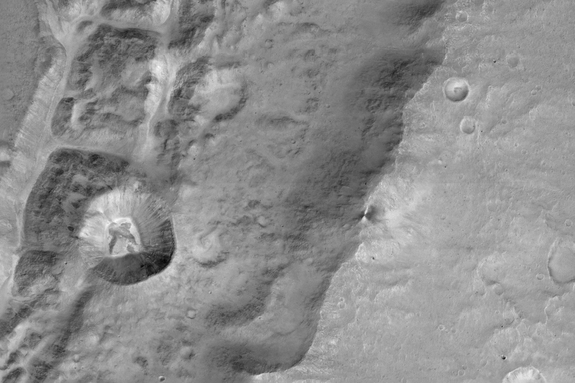 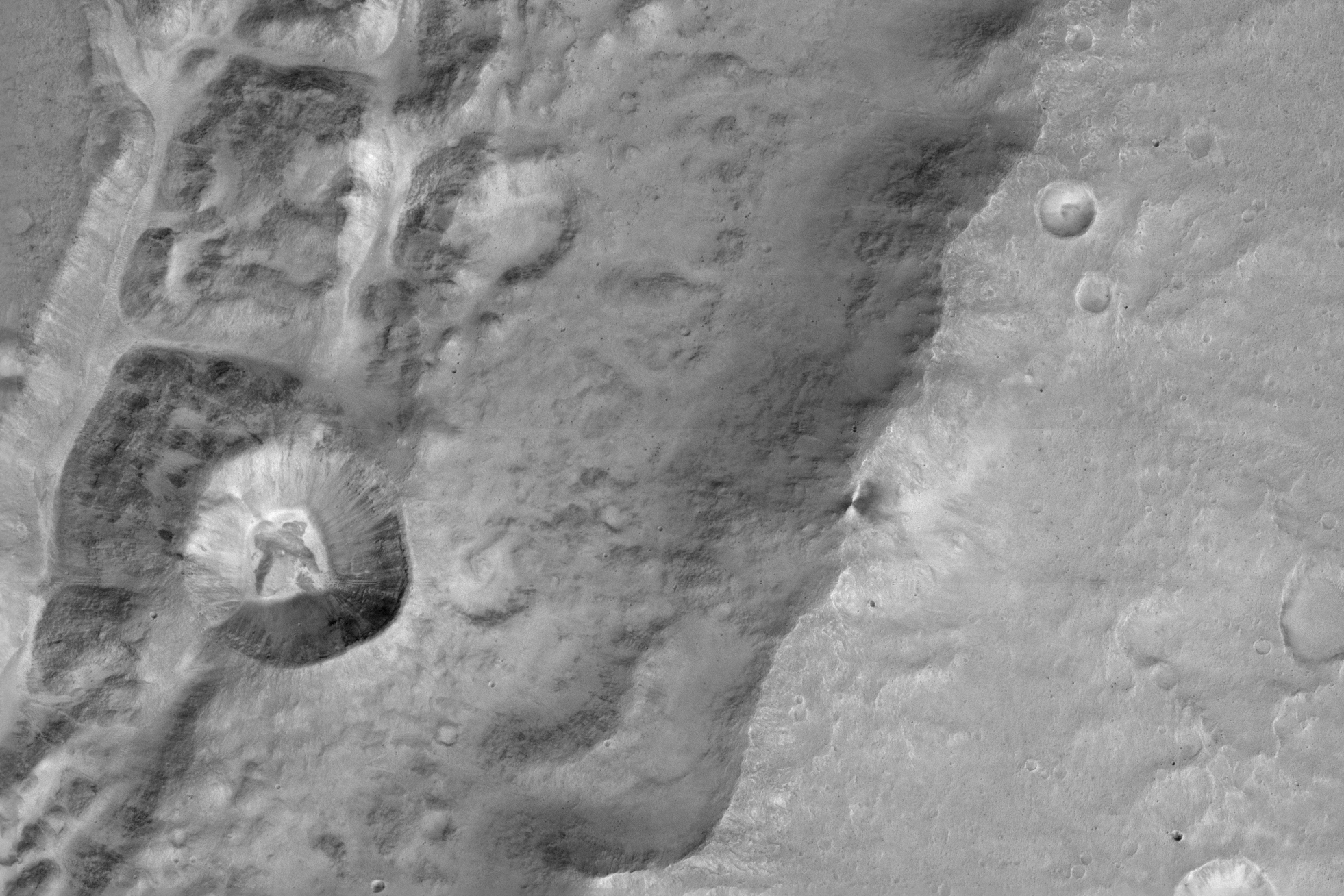 Image of a 0.9 mile-size (1.4 kilometers) crater (left-center) on the rim of a larger crater near the Mars equator. It was acquired at 7.2 meters/pixel by the Colour and Stereo Surface Imaging System (CaSSIS) aboard the European Space Agency's ExoMars Trace Gas Orbiter. Credit: ESA/Roscosmos/ExoMars/CaSSIS/UniBEThese first images allowed ESA to test the camera's color- and stereo-imaging capabilities, which would allow CaSSIS to build 3D maps of the Martian surface by combining views from different perspectives. Though the color-imaging equipment was functioning as planned, the first photos appear black and white. That's because the areas photographed are dusty ― volcanic without much color to be seen. "We will have to wait a little until something colorful passes under the spacecraft," Thomas said. 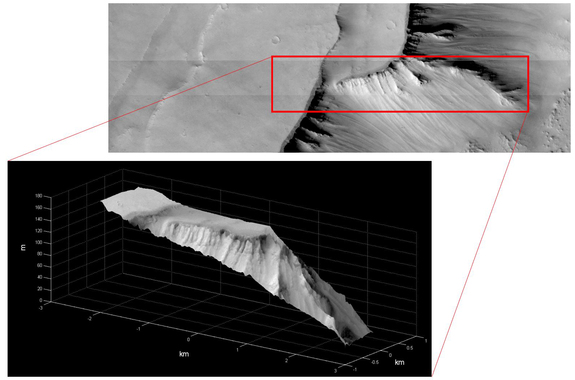 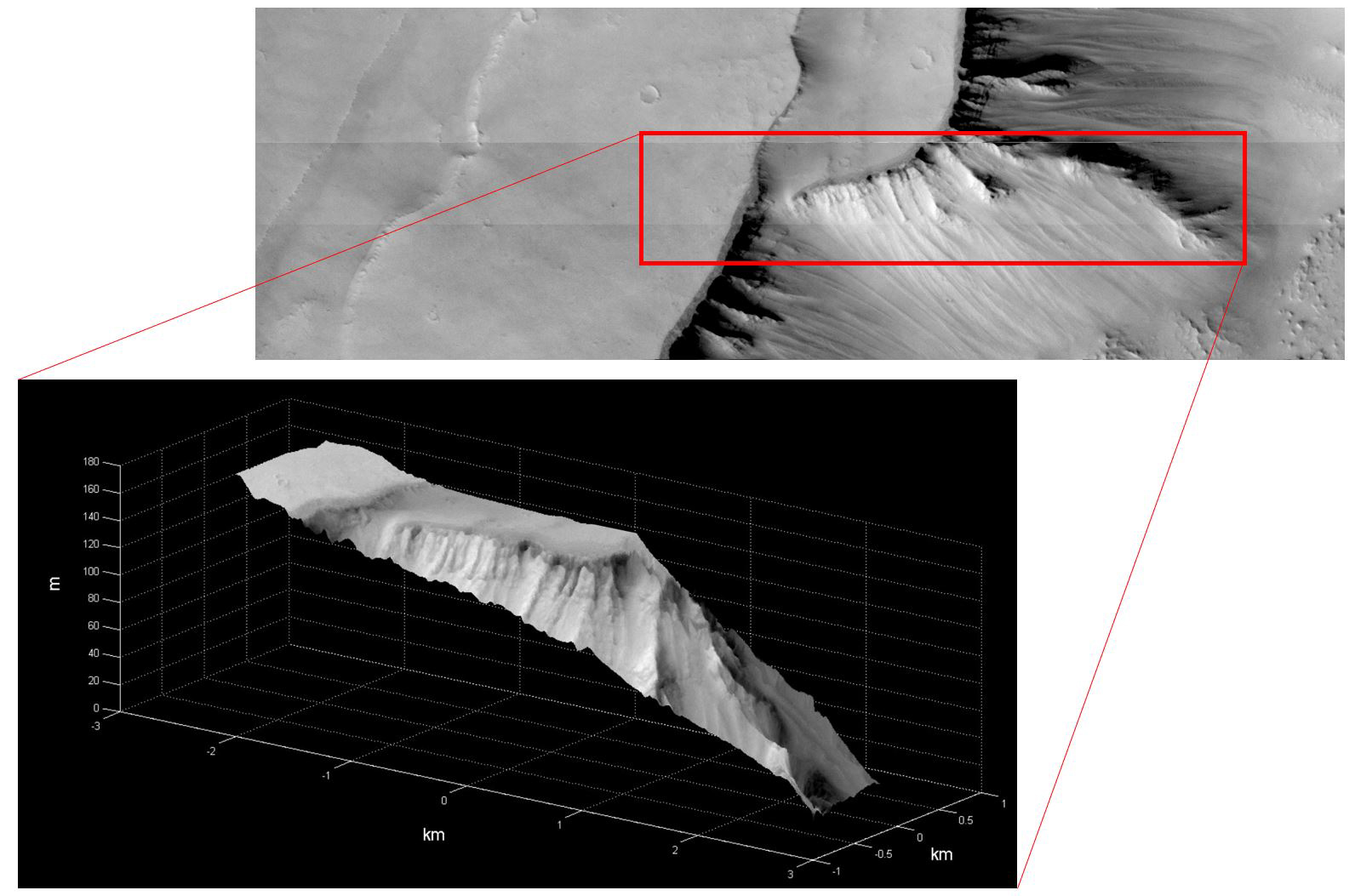 The first stereo reconstruction of a small area in Noctis Labyrinthus on Mars, created by the Colour and Stereo Surface Imaging System (CaSSIS) aboard the European Space Agency's ExoMars Trace Gas Orbiter. The image gives an altitude map of the region with a resolution of less than 65 feet (20 meters). Credit: ESA/Roscosmos/ExoMars/CaSSIS/UniBETGO is currently orbiting Mars once every four days in a highly elliptical path. At its closest, the spacecraft flies within 155 miles (250 kilometers) of the ground. These close approaches are happening quickly before the orbiter raises its altitude to about 62,000 miles (100,000 km). CaSSIS was up and running for two of these approaches during its testing phase and returned a total of 11 images. ESA then combined some of the new photos in the video above to simulate a flyover of Hebes Chasma, a 190-mile-long (310 km) canyon in the Martian surface. "We saw Hebes Chasma at 2.8 meters per pixel," said Thomas. "That’s a bit like flying over Bern at 15,000 kilometers [9,300 miles] per hour and simultaneously getting sharp pictures of cars in Zürich." 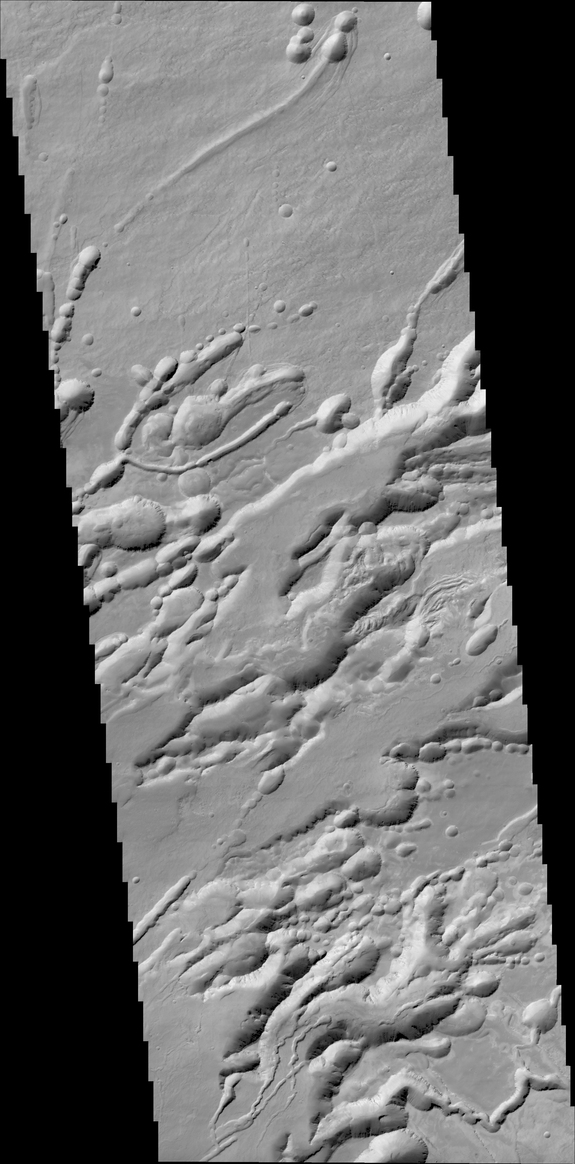 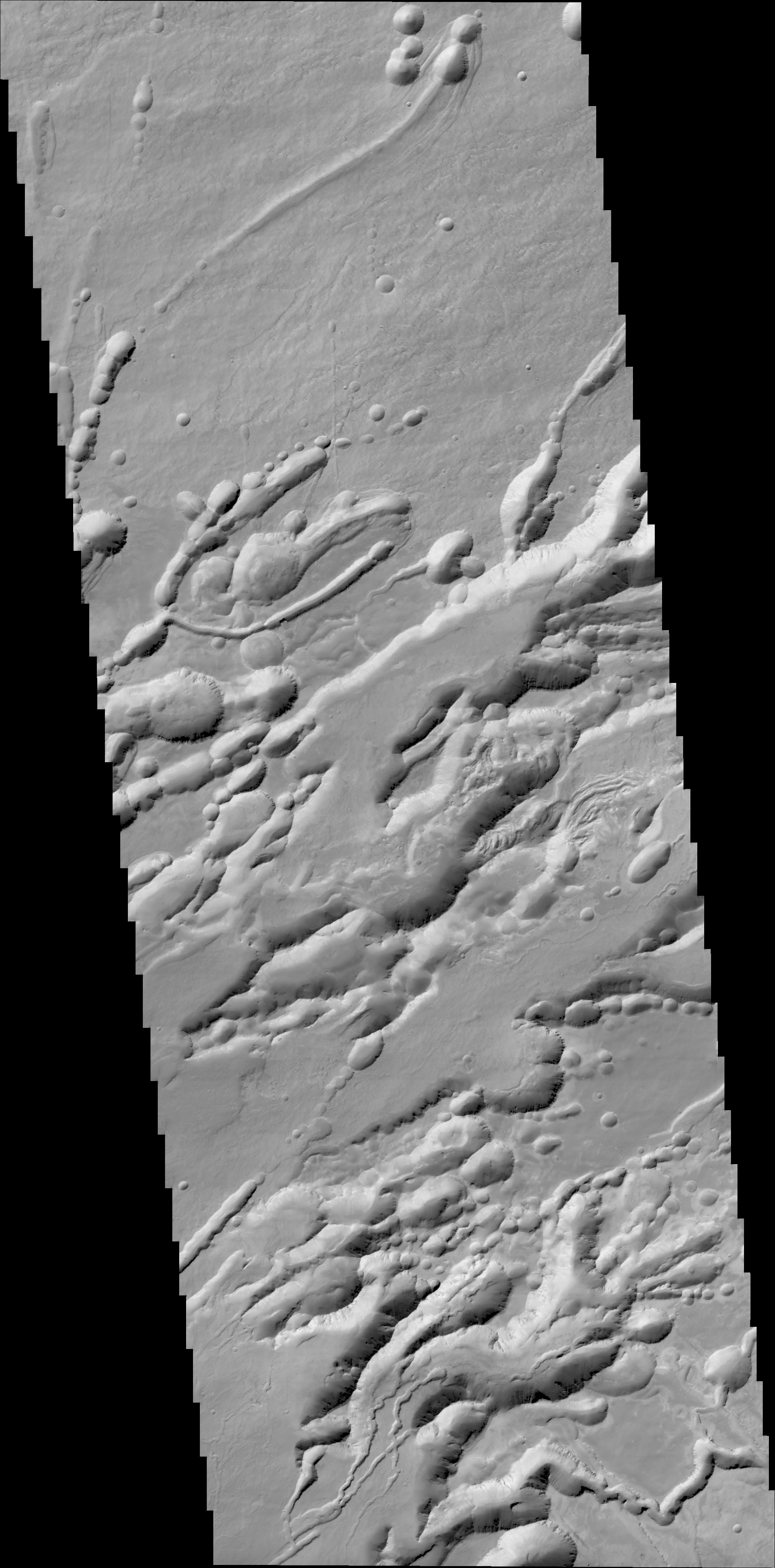 A structure called Arsia Chasmata on the flanks of one of the large Martian volcanoes, Arsia Mons. This view was created by the Colour and Stereo Surface Imaging System (CaSSIS) aboard the European Space Agency's ExoMars Trace Gas Orbiter. The width of the image is around 16 miles (25 kilometers). The formation is volcanic in origin, and pit craters are visible. Credit: ESA/Roscosmos/ExoMars/CaSSIS/UniBEAfter the botched landing of the Schiaparelli spacecraft in October, pressures have been high for the ExoMars team. "A lot of public attention has been on the failed landing of Schiaparelli, but TGO has been working really well, so we have been extremely busy in the past month," Thomas said. "We were quite nervous but it looks as though almost everything functioned as we planned it. The resulting images are really sharp," Antoine Pommerol, a CaSSIS co-investigator at the Center of Space and Habitability in Bern, said in the same statement. For the next few months, the team will continue to prepare CaSSIS for its prime mission. "The test was very successful but we have identified a couple of things that need to be improved in the onboard software and in the ground post-processing," Thomas said.
|
||||||||

